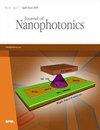Two-dimensional simple structured ultranarrow-band metamaterial perfect absorber with dielectric nanocylindrical array
IF 1.1
4区 物理与天体物理
Q4 NANOSCIENCE & NANOTECHNOLOGY
引用次数: 0
Abstract
Abstract. A two-dimensional (2D) simple structured ultranarrow-band metamaterial perfect absorber (MPA) with nanocylindrical array is studied both theoretically and experimentally. Using a dielectric 2D cylindrical array as the top grating layer of the MPA, an ultranarrow nonpolarizing absorption peak at normal incidence is obtained. Furthermore, we use the same dielectric material to simplify the topology of the ultranarrow-band MPA, and the number of film layers in the MPA is reduced from 3 to 1. By optimizing its structural parameters and metal substrate, the highest ultranarrow nonpolarizing absorption peak that approaches 1 at normal incidence is obtained. To analyze the absorption physical mechanism, the heat power density distributions of the optimized MPA are simulated to see where the incident light is absorbed. Moreover, numerical simulation results show that the main transverse-electric absorption peak of the optimized MPA is insensitive to the incident angle, and the main transverse magnetic absorption peak is sensitive to the incident angle. Finally, we fabricate an MPA sample with dielectric nanocylindrical array and measure its absorption spectra to make a further comparison. The experimental data are consistent with the theoretical ones. This method might be helpful to reduce the manufacture difficulty and cost of the ultranarrow-band MPAs and also to promote the development of applications of the ultranarrow-band MPAs.二维简单结构超窄带超材料介电纳米圆柱阵列完美吸收体
摘要从理论和实验两方面研究了一种具有纳米圆柱阵列的二维简单结构超窄带完美吸收体(MPA)。采用介电二维圆柱阵列作为MPA的顶层光栅层,获得了法向入射下的超窄非偏振吸收峰。此外,我们使用相同的介质材料简化了超窄带MPA的拓扑结构,使MPA中的膜层数从3层减少到1层。通过对其结构参数和金属衬底进行优化,获得了法向入射下最高的超窄非偏振吸收峰,其吸收峰接近1。为了分析吸收的物理机制,模拟了优化后的MPA的热功率密度分布,以了解入射光被吸收的位置。数值模拟结果表明,优化后的MPA主横向电吸收峰对入射角不敏感,而主横向磁吸收峰对入射角敏感。最后,我们用介电纳米柱阵列制备了一个MPA样品,并测量了其吸收光谱以作进一步的比较。实验数据与理论数据一致。该方法有助于降低超窄带微信号放大器的制作难度和成本,促进超窄带微信号放大器的应用发展。
本文章由计算机程序翻译,如有差异,请以英文原文为准。
求助全文
约1分钟内获得全文
求助全文
来源期刊

Journal of Nanophotonics
工程技术-光学
CiteScore
2.60
自引率
6.70%
发文量
42
审稿时长
3 months
期刊介绍:
The Journal of Nanophotonics publishes peer-reviewed papers focusing on the fabrication and application of nanostructures that facilitate the generation, propagation, manipulation, and detection of light from the infrared to the ultraviolet regimes.
 求助内容:
求助内容: 应助结果提醒方式:
应助结果提醒方式:


